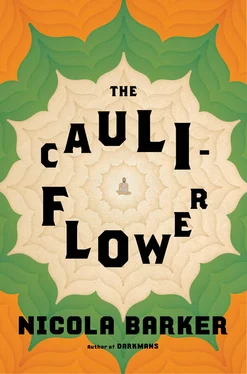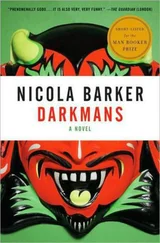Uncle is perfectly unmanageable! Who might compel him into anything? A wild stallion may be tamed, but who may tame Uncle?
Ah. Even as I ask this question I am quietly prompted with a response: Ma Kali, that is who. It is Ma Kali who will tame Uncle. And yet Uncle’s gradually developing devotion to the Goddess would express itself in yet still more displays of shocking perversity! Oh the trials Uncle would put us all through! The shame and the confusion and the heartbreak! Who can understand Uncle? Not I. Uncle is truly beyond my comprehension. But I love Uncle more than the very breath that fills my lungs. Even though I doubt him and I doubt him and I doubt him. Even so. I love him.
Twelve attempted answers to the twelve slightly impertinent questions about Ma Kali
1. The main monotheistic faiths cleave to the idea that there is one God, who is good. All evil comes from another place, a different place. In the Christian tradition, this place is the Devil. Muslims call him Shaitan . But the Hindus yearn to transcend what they call the “pair of opposites,” e.g., good/bad, love/hate, attraction/repulsion. They believe that it is necessary to do this if you are to journey beyond the limited world of the ego and its attachments, beyond the cage of relativism. To the Hindu, God is beyond “opposites,” beyond good and evil. Often the example of fire is used to illustrate this idea. We use fire to warm ourselves and to cook, but fire may also hurt us and destroy our homes. So fire transcends good and bad. The human mind, the ego , will call fire good or bad according to the context. But fire is neither good nor bad. It is simply fire. And it burns .
2. Kali is a creative, dynamic, destructive force who is both good and bad. She is Dakshina Kali (the loving Kali who grants boons and blessings) and she is Smashan Kali (the terrible, terrifying form, who destroys). Smashan Kali is traditionally worshipped in cremation grounds. These are places of ash and decay, burned bones, bad smells, and jackals.
In the west it could be argued that we sublimate this special “spiritual mood” into our phases of simmering teenage angst, or when we read books about vampires and ghosts, or watch horror films, or when we dye our hair black and become goths and listen to Joy Division or Marilyn Manson. When we celebrate Halloween, even. It’s the same fundamental impulse, and a curious irony, too, that a sense of comfort/release is sometimes felt when we actively go out of our way to embrace the sweet and sticky black treacle of darkness.
Kali’s famous cremation ground is a location in which it is suddenly rather easy to renounce the body and the ego (a bleak and despairing place — how can we possibly evade the truth of death and decomposition here?), but it is also, and equally importantly, a place where we may master something even more powerful than our ego (or our attraction to life and the living), and that’s our deep-seated fears and aversions. Our aversions are even more difficult to eliminate and overcome than our natural human weakness for cheap thrills and attractions. A true saint feels neither attraction nor repulsion nor fear.
3. People happily and readily love Kali in both of her main forms (in fact, she has countless forms — there is a custom-built Kali for all occasions) because even though she may appear to both bless us/nourish us and kill us/destroy us, she actually does neither. Our world is just a kind of transitory dream, an illusion. We exist on a relative plane. The Hindus call this earthly realm maya . And what takes place here is only divine play — a game. Life and death are inconsequential. To move beyond maya you must consciously stop playing the game; then Kali may spare you and free your soul to unite with God, with Brahman , who is the ultimate reality, in a place and state of incontrovertible truth and infinite bliss.
Life is illusion. It is maya . Kali is the puppet master. We are the puppets. She may stoop and cut our strings if she feels the sudden impulse. But take nothing for granted here. She is perplexingly coquettish and a creature of strange whims.
4. Kali spits out her tongue not as a gesture of defiance, but as an expression of embarrassment or coyness because she has (during the course of an orgy of vengeance and destruction) accidentally stepped onto the prostrate body of her beloved husband, Shiva (Shiva, who is not dead, just deathly pale and smeared in the white ash of renunciation, has lain in front of his wife to try and curtail her inexhaustible wrath). Kali is fierce, but confused. On a purely symbolic level, Kali’s tongue is red and represents rajas , or activity, but this tongue is held between her white teeth, and white is the color of sattva , or purity and spirituality. Her passion is restrained by purity, or, in other words, by God.
5. The fifty skulls that Ma Kali wears around her neck represent the fifty letters of the ancient Sanskrit alphabet. Kali creates worlds and she creates words. The ancient concept of the Logos is contained here and originates here (long before Saint John thought of it or wrote about it in his exquisite gospel), nestled in the musky bosom of the Black Mother.
6. Kali’s name comes from the word kala , or “time.” Time consumes everything. Kali is black because she is time, and she has destroyed everything. She is a giant vacuum, an endless, dark void. She is inscrutable. The ignorant devotee can only really see her from a distance. She is similar to the night sky. Draw up close and (like God, or Brahman , who is ultimately formless) she will simply disappear.
*poof!*
7. Kali’s hair is in disarray because she is wild. She is an all-singing, dervish-dancing, ecstatically stomping, bloody-sword-wielding Beyoncé Knowles. She sings to her own crazy tune. She is utterly unfettered. She is fearless. She is free.
8. Kali’s priests at the temple may dress her image in priceless sari s and cover her with precious scents and expensive jewelry — this is how they honor her, it is all a part of their divine service — but Kali herself may never be dressed. She may never be curtailed. Can you dress a storm? Can you bejewel the wind? For this reason Kali is called Digambari : she who is naked.
9. Kali cannot exist without Shiva, her husband, but Shiva (who, as he lies flat and pale at her feet, represents the blinding light of infinite consciousness) cannot manifest his destructive power without his wife, Kali. Creation and destruction are an endless cycle. One cannot exist without the other. They are two opposites, eternally conjoined. This is an eternal love affair.
10. The girdle of arms around Kali’s waist represents work or action. The arms symbolize her creative energy. They also represent — at some level — the pointlessness of all human endeavor. Everything we build will ultimately be destroyed. Nothing we do may last forever.
11. Kali provides a source of delirious bliss to her devotees (Kali herself reels about drunkenly, high on this blissful intoxication, but also, perhaps, on blood lust after slaughtering copious demons) through the physical mechanism of what Hindus call the kundalini . Kali’s energy is sourced at the base of the human spine. It extends down to a point just below the anus and then rises up to the crown of the head, traveling through the heart, the base of the throat, and the point between your eyes, at the top of your nose, en route . Her power writhes and vibrates like a snake through this channel. But it is a dangerous, overwhelming, and ecstatic energy to release, and very difficult to control once you have. Play with it at your peril, girls and boys.
Читать дальше












